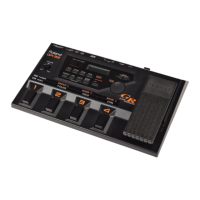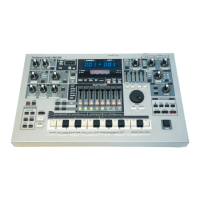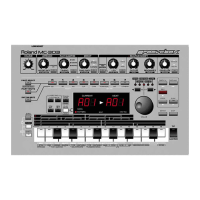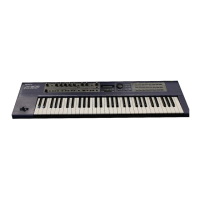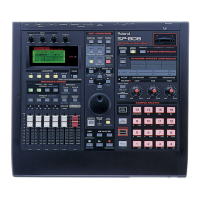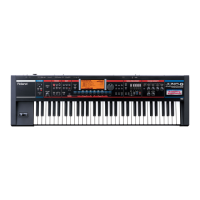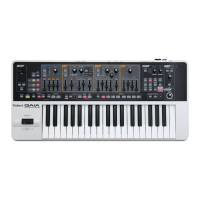20
Chapter 3 Editing The Sounds
The GR-20 lets you modify the sound to your taste. This
process is called “editing.”
When you edit the settings, the decimal point in the display
will light, indicating that the sound has been modified from
the original settings.
Selecting a Sound to Start From
Use the [BANK] knob and [NUMBER/VALUE] knob to
select the sound (patch) from which you want to start editing
(p. 14).
Use the Knobs to Adjust the
Sound
fig.3-01(knob)
* Immediately after a patch change, the sound you'll hear will
reflect the settings stored in the patch, regardless of the
positions of the knobs.
Adjusting the Attack—ATTACK
This adjusts the attack time of the sound. Turning the knob
toward the right will lengthen the time, producing a more
gradual attack. Turning the knob toward the left will shorten
the time, producing a sharper attack.
* You will hear the original sound when the knob is at the center
position.
* For some sounds, moving the knob may not make any
difference.
Adjusting the Release—RELEASE
This adjusts the release, from when you mute a string until it
decays to silence. Turning the knob toward the right will
lengthen the release, and turning it toward the left will
shorten the release.
* You will hear the original sound when the knob is at the center
position.
* For some sounds, moving the knob may not make any
difference.
With the knob turned all the way to the left, it activates the
envelope follower function.
Envelope Follower (E FLW) function
The guitar synth analyzes the vibration of your guitar string
to detect the pitch, and then plays the appropriate synth
sound. This means that if the string vibration is less than a
certain level, it will not be possible to detect the pitch, and
the synth sound will be silenced at that point. For some
patches, the way in which the sound is silenced at this time
may produce an unnatural result.
The envelope follower function causes the volume of the
synth sound to always follow the string vibration of the
guitar, making the synth sound decay naturally along with
the decay of the string vibration.
* For some patches, the effect may be slight.
* Using the envelope follower function on a decay-type synth
sound such as piano or guitar may have the opposite effect,
producing an unnatural-sounding decay.
Adjusting the Spaciousness of the
Sound—CHORUS
This adjusts the depth of the chorus effect, which gives the
sound a spacious feel. Turning the knob toward the right will
deepen the effect, and turning it toward the left will lessen
the effect.
* You will hear the original sound when the knob is at the center
position.
* For some sounds, moving the knob may not make any
difference.
Adjusting the Reverberation
—DELAY/REVERB
This controls two types of reverberation effect.
Delay is an effect that produces echo-like effects, while
Reverb is an effect that simulates the way in which sound
reflects from the walls of a hall or tunnel. The left half of the
knob’s range applies a delay effect, and the right half applies
reverb. In either case, turning the knob farther will deepen
the effect.
Adjusting the Volume—LEVEL
This adjusts the volume of the patch.
* If you want to keep your edited sound, execute Write (p. 24) to
write your settings into a USER patch.
GR-20_e.book 20 ページ 2007年7月2日 月曜日 午後12時53分
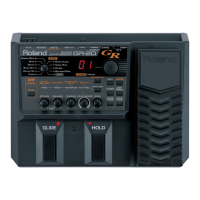
